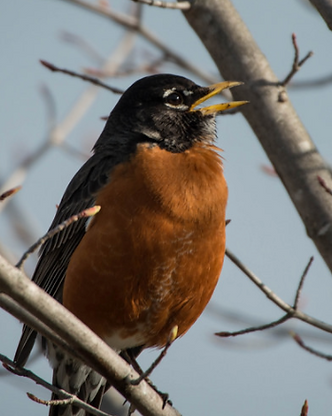American Robin

The American Robin is the most widely distributed thrush in North America and likely the most recognizable. These dark-mantled, red-breasted birds are just as likely to be found in cities and suburbs as they are to be found in forests. Like other thrushes, the American Robin sings a loud complex song. Males sing from tree tops, roofs, powerlines, and other high vantages immediately in the mornings and before and after sunset. Robin calls are a distinctive “wick-wick-wick”. Females are responsible for nest building and must wait until mud (a key feature in the robin’s nest) is available. The location where the nest is constructed is highly variable, but tends to be in places that often both structural support and cover from the elements. The female is solely responsible for incubating the eggs and receives little to no support from her mate. This means the nest is left unguarded for short periods when the female is foraging for food. Both parents typically feed the hatched young, however. Nestlings are offered soft-bodied insects, worms, and fruits. After approximately 2 weeks, nestlings will edge and remain under the care of their parents for another 3 weeks. In some cases, the adults will start a second brood. In such cases, the male will continue to rear the first brood while the female starts incubating the second.
Safe Dates: May 10th to August 1st (applicable for only the S or H codes).
Breeding Evidence: If you hear an American Robin singing (“cheerily, cheer up, cheer up, cheerily, cheer up”) within the safe dates, use code S. The simplest way to upgrade this to a “Probable Breeder” is to listen for singing again at the same location 7 or more days later to upgrade the code to S7. For silently perched or calling (a repeated “wick-wick-wick”) birds, use code H. When agitated, adults will give chuck or chirp calls (code A) and will even attack potential threats (code T). If you observe an adult bird visiting a potential nest site, use code N. If a nest with young is observed or heard, code use NY, but note that we strongly discourage closely approaching or disturbing nesting birds. For birds observed with bills full of food items to feed to their young, use code CF. Recently fledged young remain in the care of their parents for several weeks after leaving the nest. If recently edged young are observed that are incapable of strong flight, use code FL.
Image courtesy of Logan Parker.
Audio courtesy of Ted Floyd.
